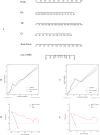Establishment and evaluation of an early prediction model of hepatorenal syndrome in patients with decompensated hepatitis B cirrhosis
- PMID: 36593456
- PMCID: PMC9809024
- DOI: 10.1186/s12876-022-02618-x
Establishment and evaluation of an early prediction model of hepatorenal syndrome in patients with decompensated hepatitis B cirrhosis
Abstract
Background and aim: In China, hepatorenal syndrome is a serious complication in the decompensated stage of hepatitis B cirrhosis, which requires early clinical intervention, so the early diagnosis of hepatorenal syndrome is crucial. This study establishes a new predictive model based on serum biomarkers for the early diagnosis of hepatorenal syndrome.
Methods: Patients with decompensated hepatitis B cirrhosis who met the inclusion and exclusion criteria were retrospectively enrolled. Patients were randomly assigned to the training dataset and validation dataset at a 7:3 ratio. Univariate and multivariate logistic regression analyses were used to screen the risk factors for hepatorenal syndrome. The identified risk factors were used to establish and verify a model.
Results: This study included 255 patients with decompensated hepatitis B cirrhosis, including 184 in the training group and 71 in the validation group. The multivariate logistic regression model was established in the training group and verified in the validation group. Logistic regression showed that hemoglobin (OR 0.938, 95% CI 0.908-0.969), total bilirubin (OR 1.014, 95% CI 1.008-1.021) and creatinine (OR 1.079, 95% CI 1.043-1.117) were independent risk factors for hepatorenal syndrome (P < 0.05). These were used to establish the model. In the training group and the validation group, the area under the ROC curve of the nomogram for the diagnosis of hepatorenal syndrome was 0.968 and 0.980, respectively.
Conclusion: The three serum biomarkers, including hemoglobin, total bilirubin and creatinine, can be used as independent early predictors of hepatorenal syndrome in patients with decompensated hepatitis B cirrhosis.
Keywords: Cirrhosis; Hepatitis B virus; Hepatorenal syndrome; Model; Predictors; Retrospective study.
© 2022. The Author(s).
Conflict of interest statement
The authors declare that they have no competing interests.
Figures




References
-
- Angeli P, Gines P, Wong F, Bernardi M, Boyer TD, Gerbes A, Moreau R, Jalan R, Sarin SK, Piano S, et al. Diagnosis and management of acute kidney injury in patients with cirrhosis: revised consensus recommendations of the International Club of Ascites. Gut. 2015;64(4):531–7. doi: 10.1136/gutjnl-2014-308874. - DOI - PubMed
Publication types
MeSH terms
Substances
LinkOut - more resources
Full Text Sources
Medical
Miscellaneous

